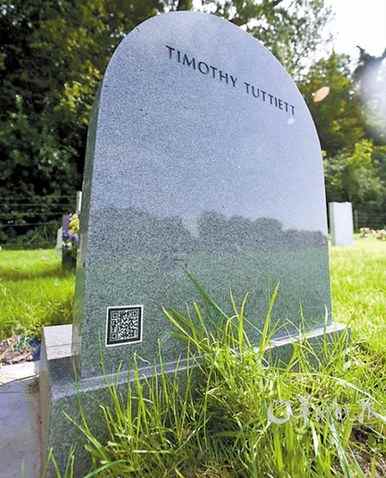几百年来,我们都用没有生命的石碑作为逝去亲人坟墓的标志,上面可能刻着逝者的姓名、生卒日期,或许还有几句墓志铭。在科技发达的今天,连墓碑也可以智能化了。英国一家丧葬机构推出一款配有二维码的墓碑,对逝者身份感兴趣的吊唁者只要用智能手机扫描二维码,手机屏幕上就会出现一个关于逝者生平、照片、视频以及亲友悼词的网页。据该机构负责人表示,除了墓碑以外,他们还可以将二维码装配在凳子、树木等任何家属选定的纪念物品上。

 |
|
A funeral home in Britain is attaching tiny digital codes to headstones, giving visitors the chance to see, hear, even experience the lives of the dead. No longer are graveyard visitors limited to letters and numbers etched into tombstones. |
For centuries we have marked our dead with lifeless granite -- graves inscribed with names, dates, perhaps small inscriptions about the departed. But stones do not tell stories.
Now, a funeral home in Britain is attaching tiny digital codes to headstones, giving visitors the chance to see, hear, even experience the lives of the dead. No longer are graveyard visitors limited to letters and numbers etched into tombstones.
The markers, known as Quick Response or QR codes, look like a combination of a barcode and Rorschach blot and are attached to the back corner of the stone. A smartphone with a QR reader can scan the code, launching websites or multimedia collections created by the family, providing an interactive life story to anyone standing over the grave, or logging in online.
"It is about keeping the memory of someone alive," Stephen Nimmo, managing director of the funeral home Chester Pearce Associates, told ABC News. "This man or woman really did something -- these are the people they knew, these are their family, this is where they went. You can learn a lot more about people than what you see on the stone."
QR codes have been used in advertisements for years, and a handful of American funeral homes began attaching them to gravestones in early 2011. This appears to be the first time they have been placed on gravestones in the United Kingdom.
Nimmo said the codes are for both visitors and the family. Anyone walking through a graveyard who spots a code can scan it. And the family can create online memorials to the dead.
"For the families, it's part of the grieving process," Nimmo said in a phone conversation from Poole, along the southern coast of England. "But it's more for strangers. Certainly in the U.K., people go to cemeteries and have a historical interest. People are more interested in not only his name, but what he looked like. For a country that doesn't talk about death, there's a morbid fascination in it."
Gill Tuttiett, 53, lost her husband Tim to heart failure in November, and was Nimmo's first customer.
"Tim was quite outward-going and game for anything," Tuttiett told the British media. "I think this is the way forward and Tim would have wanted that, and it's making a process that's hard possibly easier."
On the qr-memories.co.uk website, Gillian has written an obituary for Tim that is accessible via the code. Tim's photo stares back at the viewer, looking relaxed, with a half smile.
"Thriving on every opportunity that came his way, Tim lived life to the full, enjoying many different sports activities," the obituary reads. "A totally devoted family man, he will be greatly missed by his family and many friends. So sad that it had to end so soon."
Nimmo launched the service, which costs about $600, two weeks ago. He said he has signed up 10 customers and hasn't encountered much resistance or anyone objecting to technology impinging on tradition. He also offers versions that can attach to benches, trees -- anywhere a family has chosen to mark their loved ones.
"Sometimes, the British are reticent to doing anything new. God forbid we should do anything too modern," he said. "This has so much more information than the headstone can ever offer."
相关阅读
(Agencies)

(中国日报网英语点津 Helen 编辑)